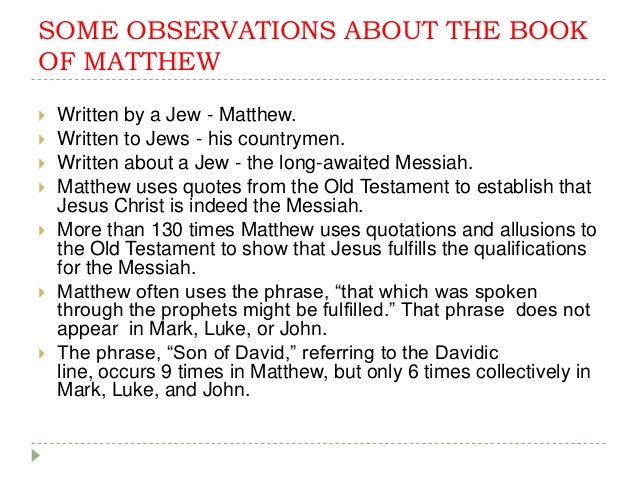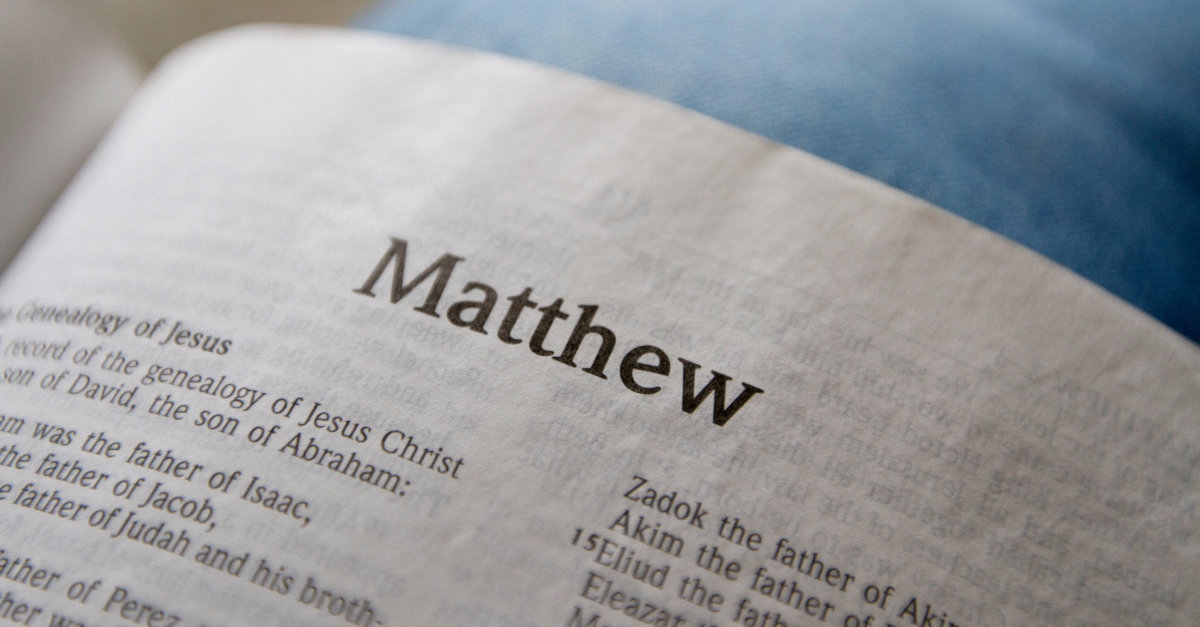Did Matthew Write His Own Book? Unraveling An Ancient Mystery
Detail Author:
- Name : Mr. Nathanael Bogisich PhD
- Username : devonte.von
- Email : kertzmann.bell@kihn.biz
- Birthdate : 1980-03-16
- Address : 91344 VonRueden Spur New Myrtie, MA 27208-4133
- Phone : 856-305-7695
- Company : McCullough PLC
- Job : Pharmaceutical Sales Representative
- Bio : Ut aliquam minus ullam ducimus molestiae. Doloribus architecto eos quisquam similique aut eaque. Dolores perferendis omnis qui ut et dignissimos ut dolores. Omnis nemo adipisci et minus.
Socials
tiktok:
- url : https://tiktok.com/@carolina8428
- username : carolina8428
- bio : Numquam laborum similique ex quia officiis minima maxime.
- followers : 139
- following : 989
linkedin:
- url : https://linkedin.com/in/gutkowski2023
- username : gutkowski2023
- bio : Quibusdam earum minima asperiores totam earum et.
- followers : 1623
- following : 495
Have you ever stopped to wonder about the stories we read, especially those from long, long ago? It's kind of fascinating, isn't it? When we pick up a book, we usually know who wrote it. But what about the ancient texts, like the Gospel of Matthew? A big question that comes up for many folks is: Did Matthew write his own book? It's a question that gets people thinking, and it has quite a history behind it, too.
This isn't just a simple yes or no answer, you see. For centuries, people have been looking at the clues, piecing together what we know, and trying to figure out the real story behind this important part of the Bible. It's a bit like being a detective, going through old documents and traditions to get to the bottom of things. So, we're going to explore that very question today.
Understanding who put these words down can actually change how we look at the message itself. It helps us appreciate the context and the purpose of the writing. So, let's pull back the curtain on this old puzzle and see what we can learn about the Gospel of Matthew and its beginnings, you know, for real.
Table of Contents
- Matthew the Man: A Brief Look
- Who Was Matthew? A Closer Look
- The Traditional View: What People Used to Think
- Uncovering the Evidence for Authorship
- The Modern Puzzle: New Ideas About the Gospel
- The Gospel's Purpose and Its Audience
- What Does It All Mean for Us Today?
- Frequently Asked Questions About Matthew
- Continuing the Conversation
Matthew the Man: A Brief Look
Before we get into the details of who wrote the Gospel, it's pretty helpful to know a little something about the person named Matthew. He's a key figure, after all, and his story is quite interesting. We often think of him as one of Jesus's first followers, and that's absolutely true. He had a different kind of job before that, though.
Matthew, you see, was a tax collector. Now, in his time, that wasn't a job people admired very much. In fact, tax collectors were often seen as outsiders, more or less. They worked for the Roman government, collecting money from their own people, and sometimes they took extra for themselves. So, they weren't exactly popular, as a matter of fact.
But then, Jesus came along and called Matthew to follow him. This was a really big deal. It showed that Jesus welcomed everyone, no matter their past or their job. Matthew left everything to join Jesus, which tells you a lot about his character, too it's almost. This change in his life is a big part of his story.
Who Was Matthew? A Closer Look
Here's a quick look at some details about Matthew, as we understand them from historical accounts and the Bible itself. It helps to put a face to the name, you know, just a little.
| Full Name | Matthew (also known as Levi) |
| Occupation Before Following Jesus | Tax Collector (Publican) |
| Role in the New Testament | One of the Twelve Apostles of Jesus |
| Mentioned In | All four Gospels (Matthew, Mark, Luke, John) and the Book of Acts |
| Traditional Association | Author of the Gospel of Matthew |
| Key Event | Called by Jesus while at his tax booth |
This table gives us a basic picture of who Matthew was. He was a person who made a big life change. His background as a tax collector, someone who dealt with numbers and records, is sometimes seen as a reason why he might have been good at writing things down. That's a thought, anyway.
The Traditional View: What People Used to Think
For a very long time, pretty much everyone believed that Matthew, the apostle, was the one who wrote the Gospel that carries his name. This idea wasn't just a guess. It came from some really early Christian writers, people who lived not too long after the events of the New Testament. Their voices were very important in shaping what people thought.
One of the most important of these early voices was a man named Papias. He was a bishop from Hierapolis, and he lived in the early second century. Papias wrote that "Matthew compiled the sayings in the Aramaic language, and everyone translated them as they were able." This statement, actually, became a cornerstone of the traditional view. It suggested Matthew wrote something, perhaps in a language other than Greek.
Other early church figures, like Irenaeus and Origen, also spoke about Matthew being the author. They saw the Gospel as a reliable account from someone who was actually there, someone who walked with Jesus. This traditional view held strong for centuries, more or less, and it was the accepted wisdom for a very long time. It felt right, you know, that an apostle would write down what he saw.
Uncovering the Evidence for Authorship
So, what exactly did these early Christian writers base their belief on? And what other hints do we have that point to Matthew as the writer? We can look at a couple of things: what the early church leaders said, and what the Gospel itself seems to tell us. It's like gathering clues, pretty much.
Early Church Voices
As we talked about, Papias's statement is key. He lived close enough to the time of the apostles to have heard things directly or from people who did. His mention of Matthew collecting "sayings" is interesting. It makes us wonder if Matthew wrote down a collection of Jesus's words first, and then that collection was later used to build the full Gospel. That's a possibility, in a way.
Other writers, like Eusebius, a church historian from the fourth century, also confirmed this tradition. They all seemed to agree that Matthew was the one. This widespread agreement among early Christian thinkers gave the traditional view a lot of weight. It wasn't just one person saying it, but many, across different places, that is that.
This early consensus suggests that there was a strong belief in Matthew's role. It's hard to imagine why they would all agree on this if it wasn't based on something real, you know? They had no reason to make it up. Their writings are a very important part of our historical record, too.
The Internal Clues
Beyond what early writers said, some people look at the Gospel of Matthew itself for hints. For example, the Gospel has a strong focus on Jewish customs and the Old Testament. It often shows how Jesus fulfilled prophecies. This kind of focus might fit a Jewish tax collector who was good with details and familiar with the scriptures, arguably.
Also, the Gospel of Matthew is the only one that mentions "Matthew" by name when describing the call of the tax collector. Mark and Luke call him "Levi." This small detail, some people think, could be a subtle hint from the author. It's like the author is saying, "Yes, that's me, Matthew," but in a quiet way. It's just a thought, you know, but it makes you think.
The Gospel also includes a lot of detailed teachings of Jesus, organized into long sections. Think of the Sermon on the Mount, for instance. A tax collector, someone who dealt with numbers and keeping careful records, might have been especially good at remembering and organizing these teachings. This kind of skill would have been helpful for writing a book like this, pretty much.
The Modern Puzzle: New Ideas About the Gospel
Now, while the traditional view was strong for a long time, things started to shift a few centuries ago. People began to look at the Gospels with new eyes, asking fresh questions. They noticed some things that made them wonder if the story of Matthew's authorship was quite as simple as it seemed. This led to what we call the "Synoptic Problem," among other things.
Modern scholars, those who study the Bible very closely, began to notice the similarities between Matthew, Mark, and Luke. These three Gospels are so much alike in their stories and even their wording that they are called "Synoptic Gospels." "Synoptic" just means "seeing together," because they share so much material. This similarity is where the puzzle really begins, you know.
The Synoptic Problem: A Big Question
If Matthew wrote his Gospel first, as the tradition suggests, why does so much of it look like Mark's Gospel? Mark's Gospel is shorter, and many scholars believe it was written earlier. It seems that Matthew and Luke both used Mark as a source when they wrote their own Gospels. This is a big part of the Synoptic Problem, actually.
Think about it: if Matthew was an eyewitness, why would he need to use Mark's Gospel, which was written by someone who wasn't an apostle? Mark got his information from Peter, but Matthew was right there with Jesus. This question makes people wonder if the author of Matthew's Gospel was simply putting together information from different sources, rather than writing it all from memory. It's a bit of a head-scratcher, in some respects.
This idea, that Matthew used Mark, challenges the traditional view that Matthew wrote his Gospel completely from scratch, or that his was the first. It suggests a more complex process of writing. It makes us think about how these ancient texts came to be, you know, like how they were put together.
The Mystery of the Q Source
Another big part of the modern discussion is something called the "Q source." This isn't a physical book we've found, but rather a theory. Scholars noticed that Matthew and Luke share a lot of Jesus's sayings and teachings that are *not* found in Mark. So, where did these shared sayings come from? They proposed a common source, which they called "Q" (from "Quelle," the German word for "source"), that Matthew and Luke both used. This is a pretty widely accepted idea, you know.
If Matthew used both Mark and this "Q" source, it again suggests that the Gospel wasn't just written by an eyewitness from his own memory. It implies a process of gathering and arranging existing materials. This doesn't mean Matthew wasn't involved, but it might mean his role was more like an editor or compiler, rather than someone writing everything fresh. It's a different way of looking at it, anyway.
The Q source idea helps explain the similarities between Matthew and Luke where Mark is silent. It's a way to make sense of the patterns we see in the Gospels. It's a really clever idea, if you think about it. It helps solve a puzzle that has been around for a long time, you know, sort of.
The Role of a Scribe or Editor
Given these modern observations, many scholars today think that the Gospel of Matthew might have been written by someone who was a disciple of Matthew, or perhaps a scribe working under his guidance. This person would have taken Matthew's original notes or sayings (perhaps the Aramaic collection Papias mentioned) and combined them with other sources, like Mark and Q. This would have been a very big job, you know.
This doesn't necessarily mean Matthew had nothing to do with it. It just means the final Greek Gospel we have might be the result of a process. It could be that Matthew provided the core ideas and some material, and then someone else put it all together in the form we read today. This kind of collaborative writing was actually quite common in the ancient world, too.
So, when we ask, "Did Matthew write his own book?" the answer might be more nuanced. He might have been the inspiration, the main source of information, or the one who started the ball rolling. But the actual writing, the final version, might have been done by someone else, or a group, working with his material. It's a bit like a team effort, in a way.
The Gospel's Purpose and Its Audience
Regardless of the exact author, the Gospel of Matthew has a very clear purpose. It was written to show that Jesus was the Messiah, the long-awaited King that the Jewish people had been expecting. It often connects Jesus's life and teachings directly to the prophecies in the Old Testament. This focus suggests it was written primarily for a Jewish audience, or at least for people familiar with Jewish traditions, you know.
The Gospel also includes many of Jesus's teachings, arranged in a very orderly way. This made it a great resource for teaching new believers and for showing how Jesus's message fit within the larger story of God's plan. It's a very structured book, which is something you notice right away, basically.
Understanding the purpose and audience helps us read the Gospel better. It helps us see why certain stories are included, and why certain points are emphasized. It gives us a clearer picture of what the writer wanted to achieve, you know, at the end of the day.
What Does It All Mean for Us Today?
So, after looking at all this, what's the takeaway? Does it really matter if Matthew literally put pen to parchment himself, or if someone else did it based on his notes? For many, the answer is that the message and meaning of the Gospel remain just as powerful, regardless of the precise hand that wrote it down. The important thing is the content, honestly.
The Gospel of Matthew gives us a powerful account of Jesus's life, his teachings, and his mission. It has shaped faith for thousands of years. The debate about authorship is mostly about historical accuracy and how ancient texts were put together. It doesn't take away from the spiritual value of the book, you know.
It also reminds us that ancient writing practices were different from ours. Books weren't always written by one person in isolation. Sometimes, they were the result of a community's efforts, or a student carrying on a teacher's work. This understanding can actually deepen our appreciation for these old texts, you know, for real.
Ultimately, the question "Did Matthew write his own book?" leads us to a richer, more nuanced view of how the Bible came to be. It encourages us to think critically and to appreciate the complex history behind the words we read. It's a fascinating journey of discovery, really.
Frequently Asked Questions About Matthew
Here are some common questions people often have about Matthew and his Gospel, you know, like things that come up often.
Was Matthew an apostle?
Yes, absolutely. Matthew was one of the twelve apostles chosen by Jesus himself. The Gospels all agree on this. He was there for many of the events he writes about, or that are written about in the Gospel bearing his name. This is a pretty clear point, you know.
What is the Synoptic Problem?
The Synoptic Problem is the puzzle of how the Gospels of Matthew, Mark, and Luke are so similar, yet also different. Scholars try to figure out which Gospel came first and how the others used it as a source. It's about understanding their literary relationship, you know, how they connect.
When was the Gospel of Matthew written?
Most scholars believe the Gospel of Matthew was written sometime between 80 and 90 AD. This is after the destruction of the Temple in Jerusalem in 70 AD, which the Gospel seems to refer to. It's a bit later than Mark's Gospel, generally speaking.
Continuing the Conversation
Learning about the authorship of the Gospel of Matthew is just one piece of a much larger story. It's a great way to start thinking about how ancient writings were created and passed down. There's so much more to explore about the Bible's origins and its enduring message. You can learn more about the Gospel of Matthew and its background from various sources, too.
We hope this look at "Did Matthew write his own book?" has given you some new things to think about. It's a topic that continues to spark curiosity and discussion among people everywhere. You can learn more about ancient texts on our site, and perhaps even link to this page about biblical history for more insights. There's always more to discover, you know.


